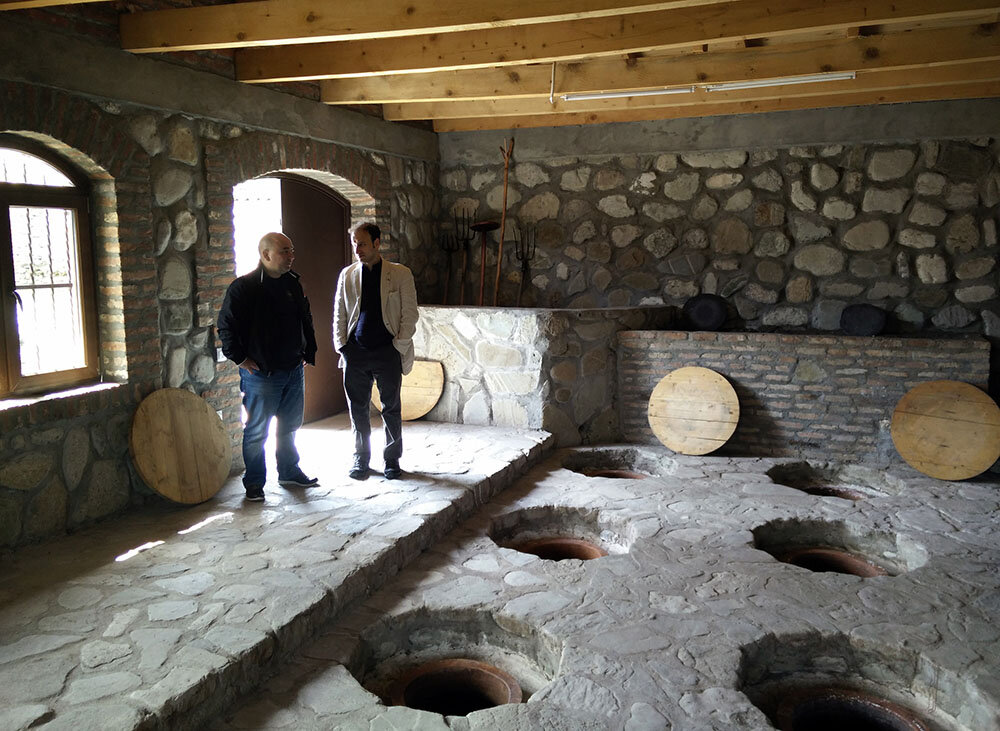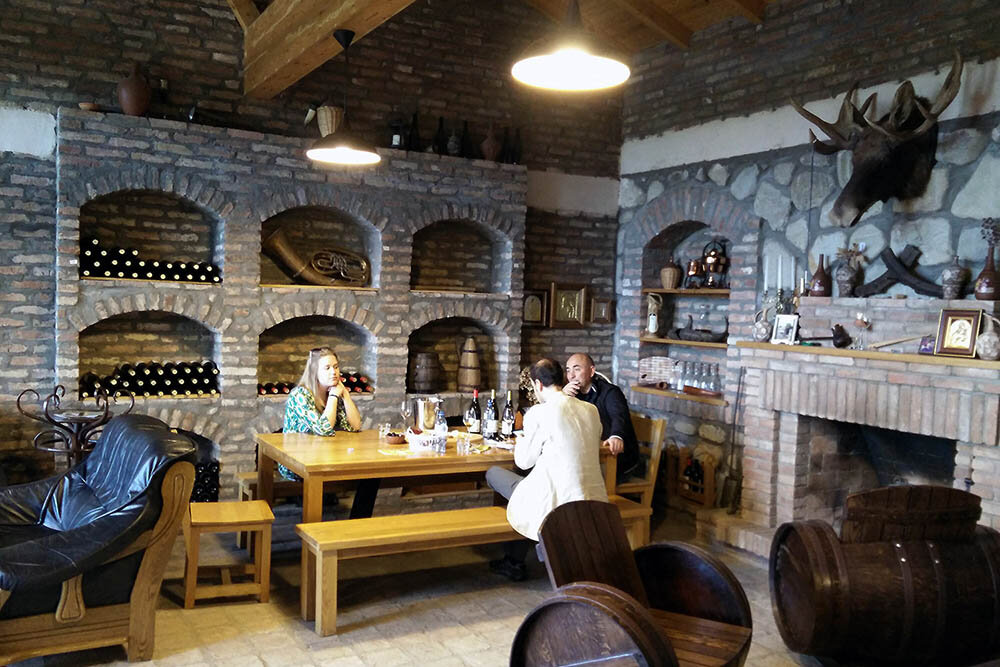A masterclass in Georgian winemaking with Giorgi Dakishvili
I’m standing in the middle of a broad valley floor in eastern Georgia, contemplating the immense wall of cloud-strewn peaks to the north. Chilly winds wrinkle the surface of the Alazani River in front of me and ruffle the manes of the wild ponies grazing on its bank. However, the scent of spring is in the air, the vines are beginning to flower and the oenophile part of me feels I’ve come home. For this place – Kahketi, at the foot of the Caucasus mountains – is not only the home of Georgian wine: it is the home of all wine.
In the beginning
Archaeological evidence from the Caucasus reveals that vessels had been used deliberately to ferment grapes around 6,000 BCE. This means winemaking traditions from the Caucasus significantly predate those of the Phoenicians, the Greeks and the Romans. Even Old Testament accounts of winemaking occur a full four millennia after wine was starting to be made in the Caucasus. No other region on the planet can adopt a marketing slogan with the sense of history conveyed by that of the Georgian wine authority: "8,000 vintages". Wine lovers throughout the world and throughout history owe a debt of appreciation to Georgia – and to Kakheti, in particular.
A unique type of clay found in the alluvial river valleys of Kakheti has been used for over eight millennia to create kvevri (pronounced "ku-ev-ri" and often spelled – apparently incorrectly – as qvevri in English) – the earthenware vessels used to ferment wine in the traditional Georgian manner. The composition of the clay is important. It must be pliable enough to work with the hands, yet strong enough to provide structural integrity for large vessels: while in modern times, most kvevri hold around 2,000 litres, the largest kvevri are over four metres tall, with a capacity of 10,000 litres! Kvevri are still made by hand today, using ancient, artisanal practices that are in danger of dying out.
Millennia of grape growing, clay gathering and kvevri firing has ensured that to this day, winemaking is in the blood of all Georgians. Everyone has a relative or friend involved in winemaking – if they’re not doing it themselves in their spare time. Driving around Kakheti, one can hardly fail to spot the Soviet-era solid metal trellises, heavily wrapped in grapevines, that adorn the front gardens of virtually every house. At one point during our tasting trip, our taxi driver apologised that he could not take us to his place for a wine tasting: he and his friends had already completely consumed the fruits of last year’s harvest!
Thus, it is not as though any Georgian decides to become a winemaker: a Georgian is born a winemaker. However, someone who has taken Georgian winemaking to its pinnacle is Dr Giorgi (Gogi) Dakishvili – perhaps the foremost expert on Georgian winemaking operating today. Giorgi is a softly-spoken man with a spark in his eye and a warm face that looks far too youthful to belong to that of a grandfather. He studied viticulture and oenology formally at Odessa, in what was then the USSR, and now has his hands full with myriad wine projects in Georgia, working with both conventional (European) vinification and traditional Georgian kvevri winemaking.
A cellar full of kvevri
Giorgi meets us at Vita Vinea, a small, beautifully furnished wine estate on the outskirts of Telavi – a gateway town to the Kakheti region. Vita Vinea is a family project, primarily run by Giorgi’s sons – with help from the third generation. Here, kvevri wines are made from fruit sourced from the Dakishvili Family Vineyards – a 4ha estate in the Kondoli Valley, 10km away. At Vita Vinea, the Dakishvilis focus on native Georgian varieties: in particular Rkatsiteli, Kisi (both white), and Saperavi (red).
We are first shown into the cellar: a clean, airy structure with wooden beams, stone walls and a flagstone floor. Some interesting tools are positioned around the room – pitchforks, a puncheon (a wooden disk mounted perpendicularly to a broomstick), and what looks like the trunk of a sapling with three truncated branches at one end. Set into the floor are eight circular openings, made from clay and arranged in a two-by-four grid, each just large enough for a (slim) person to fall into. Beneath our feet is the heart of the operation – the kvevri themselves.
The eight kvevri at the Dakishvili estate are all 2,000 litres capacity. As a comparison, a traditional French barrique contains 225 litres, meaning the maximum total production at Vita Vinea is a mere 71 barrels of wine! Like all kvevri, these ones were made to order by hand and brought to the cellar to be buried underground during construction. The floor and building are literally built around them! Kvevri are most certainly not amphorae (which were invented much later, and used primarily for the transportation and storage of liquid; kvevri are not designed to be moved) yet they share a broadly similar shape: that of an elongated, bulbous root vegetable, with a tapered tail, moving to a subtle bulge that closes off at the neck opening.
The outer surface of the porous clay vessel is coated in lime before burial and the inner surface is coated with beeswax. Kvevri winemaking is ‘natural winemaking’ in its purest expression, thus scrupulous hygiene must be observed to prevent microorganism spoilage of the wine. During the off-season, a paste of lime ash (calcium hydroxide mixed with firewood ash) is applied inside the kvevri to keep it clean. This is washed off using a water, ash and calcium solution immediately before the harvest. (And yes, people do go inside to facilitate this cleaning process!)
According to Giorgi, the main effect of using kvevri instead of oak barrels or stainless steel vats for vinification is in the thermal properties of the vessel during fermentation. This is facilitated both by the shape of the vessel, which promotes temperature eddy currents in the fermenting wine, leading to effective mixing, and the fact that it is buried underground, providing a natural insulation. There is no significant exchange of particles, flavour, or oxygen from the clay to the wine. If anything, a small amount of calcium may come from the clay into the wine, and air only comes into contact with the wine at the neck opening.
Traditional kvevri winemaking
Grapes are usually harvested in the morning, before it gets too warm outside: they arrive in the winery at about 18ºC. The approach to crushing and pressing the grapes varies by winery and variety, but typically the juice is extracted, placed into kvevri and the stems and skins shovelled in on top. In most cases, all the skins and stems are added to the must. A two-week fermentation proceeds, with the ferment temperature peaking at around 28–30ºC. During the ferment, the curious array of tools we observed in the Vita Vinea cellar are used to punch down the cap three times per day. This is important to allow oxygen into the wine, facilitating the polymerisation of tannins – the process that ‘softens’ the experience of tannin in the wine.
After the yeast fermentation completes, the malolactic conversion is allowed to take place, then a small amount of sulfur is added, and the skins start to sink to the bottom of the vessel. By this stage the wine has returned to the ambient soil temperature of around 14ºC. The kvevri are covered – traditionally with clay, but these days glass covers with rubber seals are more commonly used. And there the wine remains over the winter, resting peacefully.
Spring brings slightly warmer temperatures even to the well-insulated kvevri, along with increased risk of microbiological spoilage. For this reason, Giorgi keeps his wine in kvevri no longer than six months. It is then pumped out to a neutral vessel – old oak or stainless steel for the Dakishvili wines, although some producers are using new oak – to remain for several months (or years) before bottling, which usually happens without filtering.
The taste sensation: kvevri wine in the glass
After the cellar tour, Giorgi leads us into the tasting room, whose stone paving and timber eaves echo those of the cellar. Vita Vinea wines lie nestled in brick recesses in the walls; old family portraits sit on mantelpieces alongside miniature clay models of kvevri, which Giorgi uses to demonstrate the thermal gradients set up in the vessel during fermentation.
In Georgia one almost never has wine – not even to taste – without food. Thus, platters of the local cheese, breads and olives are laid out for us on the tasting table. And as Giorgi graciously and patiently answers even our geekiest of questions, he gently introduces us to his three single-varietal wines – all vintage 2015.
In Giorgi’s view, the ideal grape varieties for kvevri wine are thin-skinned. The winemaking practice will naturally extract tannins, which can be unexpected for modern palates to experience in a ‘white’ wine. Thinner skinned varieties ensure these tannins come through with elegance and the natural fruit flavours of the grape are not obscured. This is important as the higher temperature fermentation can suppress the vibrant fruit characteristics the modern palate expects. The effect of skin thickness during fermentation was demonstrated beautifully in the tasting of the Vita Vinea whites.
In the glass, the Rkatsiteli (13% abv) shows as a bright amber. Known by some as ‘the Chardonnay of Georgia’ it correspondingly has a fairly neutral aroma profile: untoasted pine nut and sourdough rather than overt fruits – due in part to its relatively thick skins. The flavours on the palate follow in the same manner but what is really striking about this wine is the texture! It has a crisp, vibrant, acidity that couples with soft, gently persistent tannins to produce a broad textural experience as the wine progresses along the palate. The finish arrives perhaps sooner than I would like, but with subtlety and elegance.
The Kisi (13% abv) is a completely different creature. A deeper colour than the Rkatsiteli and far more overtly fruity – a hallmark of its thinner skins. I picked up notes of dried apricot, papaya and butterscotch – characters of the variety – coupled with walnut and fresh pine nut – notes I was now beginning to recognise as a facet of the kvevri winemaking practice. The palate showed immense poise and a delicacy of flavour I was not expecting given the robustness of the aroma profile. Once again, a savoury character came through on the palate, along with a gentle white peppery spice. The tannins were fine-grained with a little more precision and grip compared to the Rkatsiteli.
Saperavi is also a thin-skinned variety and has been the workhorse grape of Georgia’s wine industry since the Soviet occupation, when Georgia was co-opted into producing bulk wine for the Bolshevik elite. It appears in the glass with a bright purple-blue hue. The Vita Vinea example (13%) is strikingly aromatic with notes of blueberry, blackberry and raspberry, accompanied by a spicy, slatey quality. The fruit hits the palate initially, but is swiftly overtaken by a saline, savoury mid-palate: black olive and a sensation I can only describe as ‘hot red brick’. The finish is long and tapered – some Saperavi I’ve had ended abruptly with a vaporous alcoholic whiff – none of that here. The tannins persist to the end, suppleness and ripeness encoded within this ‘dusty terracotta’ tannin profile.
The Georgian resurgence
The hippest sommeliers all over the world are turning to amber (or ‘orange’) wine as the ‘Next Big Thing’ in wine. In the trendiest of wine bars, these wines are becoming a staple of wine lists, and I predict it will only be a small matter of time before larger outlets, wine retailers and even supermarkets start selling these skin contact wines. One of the ironies of this movement to celebrate the ‘new’ in wine is that it is a reversion to the way in which wine has been made for over 8,000 years – at least in one part of the world. Sadly, the quality of Georgian wine suffered immensely under Soviet occupation as did the country’s economy. It’s only been in the past decade that a vestige of stability and prosperity has returned to the nation. With this has come increased investment in the wine industry, a newfound appreciation for traditional Georgian winemaking, and new markets for traditional kvevri wine around the world. This has provided the freedom for the talented stalwarts of the winemaking community – like Giorgi Dakishvili – to allow the expression of truly heritage winemaking. Georgian wine is coming to a town near you. Stay tuned!
Vita Vinea is imported into the UK by Clark Foyster.







